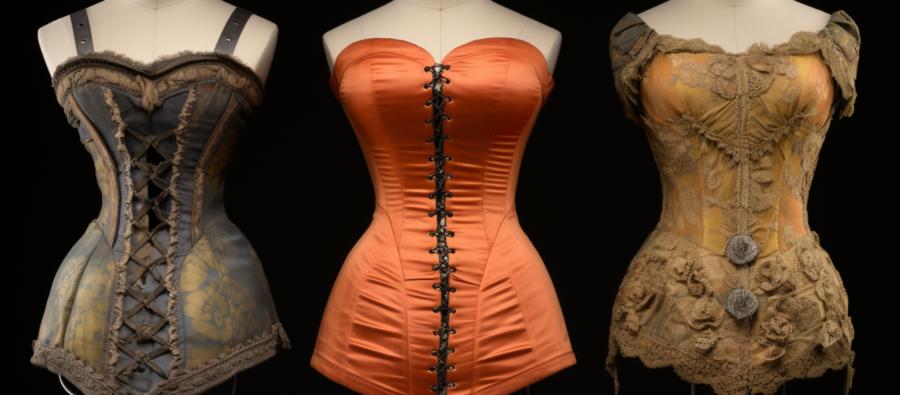Victorian Corsets: 19th Century London's Tight-Laced Trend

Ah, the Victorian Era! A time of prudence, propriety, and...crushing one's internal organs?
Indeed, my dear reader, it was during this most decorous of times that the fashion of tight-lacing corsets reached its arguably absurd peak. Allow me to take you on a journey through the streets of 19th Century London, where ladies of high society were quite literally squeezing themselves into the latest sartorial craze.A Brief History of the Corset
First, a little background. The art of shaping the female form with the help of a corset has been a rather contentious practice throughout history. While certain styles of corsets have existed since antiquity, it was during the Victorian Era that this garment reached its most extreme - and potentially harmful - proportions.Victorian corsets were designed to cinch a woman's waist as tightly as possible, in order to achieve the highly coveted hourglass figure. The ideal waist measurement at the time was a mere 18 inches, but some women reportedly went as far as compressing their waists to a mind-boggling 15 inches (or even less!). This was, of course, no easy feat. Corsets were constructed with stiff boning, usually made from whalebone or steel, and were tightened with laces that could be pulled as taut as the wearer could bear.
The Dangerous Consequences of Tight-Lacing
Now, one might think that this practice of quite literally taking one's breath away would have led to a host of health issues, and they would be correct! Wearing a corset that was too tight could cause fainting, indigestion, constipation, and even fractured ribs. Some women even had their lower ribs surgically removed in order to achieve a smaller waistline - an extreme and dangerous procedure that was anything but a laughing matter.Additionally, the constant pressure on a woman's internal organs could lead to a whole slew of other problems, such as the displacement of the liver and the compression of the lungs. This, in turn, could result in difficulty breathing, and a host of respiratory issues. It was not uncommon for women to faint or suffer from shortness of breath due to their restrictive corsets - a malady that was so prevalent, it became known as the "corset cough."
The Tight-Lacing Controversy
As you might imagine, the practice of tight-lacing did not go without its share of controversy. During the 19th Century, numerous doctors and other medical professionals spoke out against the harmful effects of corsets, and the practice was widely criticized.One such critic was Dr. Samuel Thomas von Sömmerring, a prominent German physician. In an 1818 article titled "On the Deformities and Inconveniences Produced by the Present System of Female Dress," von Sömmerring argued that tight-lacing was not only dangerous, but also an affront to the natural beauty of the female form. He wrote, "Nature has given to woman a form which corresponds with the delicacy and beauty of her sentiments, and which is admirably adapted to her destined functions. To attempt to improve upon this by art is not only ridiculous, but highly injurious."
A Fashionable Rebellion: The Birth of the Rational Dress Movement
Fortunately, as the 19th Century wore on, an increasing number of women began to reject the constrictive corsets of the day. This led to the emergence of the Rational Dress Movement, which advocated for clothing that was both fashionable and functional, allowing women to move and breathe freely.- One of the key figures in this movement was Amelia Bloomer, an American women's rights activist who famously donned a pair of loose, billowing trousers (which would later become known as "bloomers") in lieu of a corset.
- Another notable figure was the French designer Paul Poiret, who introduced a revolutionary new silhouette in the early 20th Century. His "Directoire" style featured a higher waistline and a more natural fit, effectively liberating women from their restrictive corsets.
Lessons from the Tight-Laced Trend
So, what can we take away from this jaunt through Victorian London and its fashionable follies? Perhaps the most important lesson is that while fashion trends may come and go, prioritizing one's health and well-being should always remain in vogue.Furthermore, the Rational Dress Movement demonstrates the power of collective action and the importance of questioning societal norms. By pushing back against tight-lacing and advocating for more sensible styles, the women of the 19th Century paved the way for future generations to enjoy greater freedom and comfort in their clothing choices.
As we continue to navigate the ever-changing landscape of fashion, let us never forget the lessons of the corset and the brave women who dared to challenge convention, one loosened lace at a time.
Article kindly provided by foreverinfashion.org
Latest Articles
- The Psychology of Tattoo Aesthetics: Why Certain Imagery Resonates
- Style That Works With Your Body, Not Against It
- Fashion Tourism on Wheels: Curated Shopping Routes Led by Chauffeur Guides
- The Charm of Certainty in a World of Indecision
- Can an Everyday T-Shirt Be Turned into a Modern Heirloom?
- Color, Ceremony, and the Psychology of Celebration
- Styling Graphic T-Shirts for Different Body Types
- Getting Kids to Wear Their Hats Without a Bribe or a Meltdown
- Mastering the Art of Being the Unnoticed Photographer
- Quiet Sportswear Moves Loudly
- Fashion's Most Misunderstood Color Is Brown
- Weight Matters When Cotton Gets Real
- SKU's Out for Summer: Why Your Warehouse Is Melting Down
- Ink as Accessory - How Tattoos Are Replacing Jewelry in Modern Style
- Accessories
- Jewellery
- Footwear
- Skirts and Dresses
- Shirts and Blouses
- Beauty and Makeup
- Fashion Photography
- Sustainable Fashion
- Street Style
- Fashion History
- Fashion Business
- Fashion Styling
- Fashion Events
- Plus-Size Fashion
- Men's Fashion
- Women's Fashion
- Fashion Blogging
- Fashion Trends
- Fashion Retailers
- Fashion Tips and Advice
- Fashion Business Startups
- Fashion Around the World
- Lingerie
- Sportswear
- Weddings

